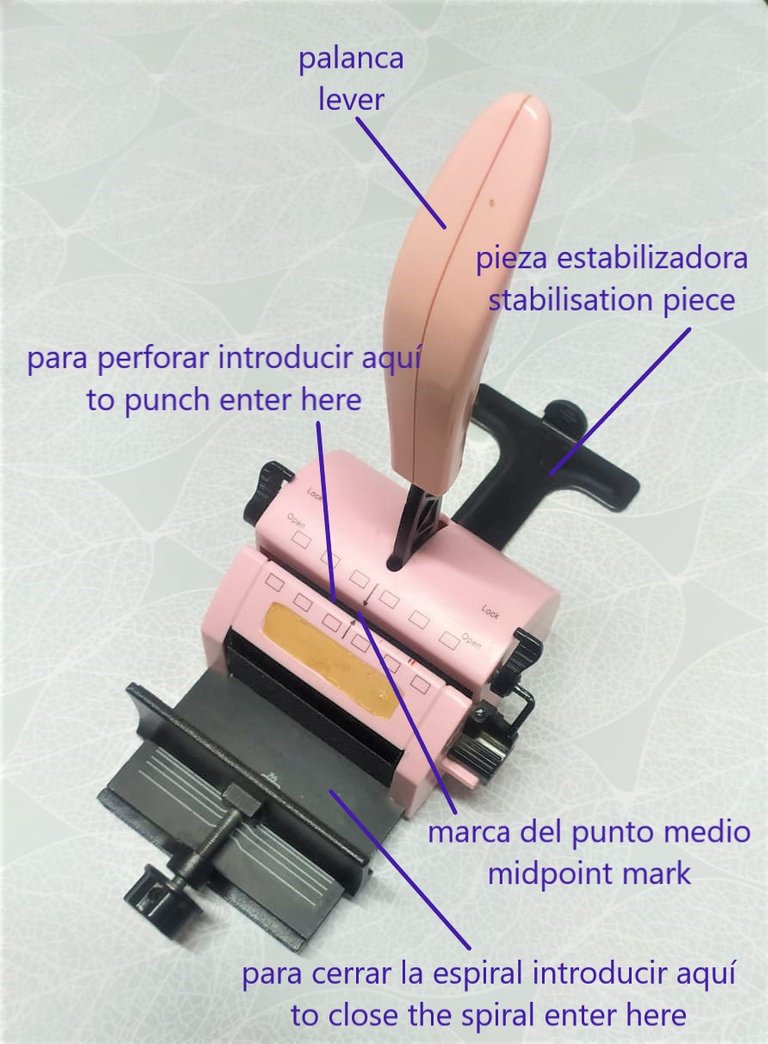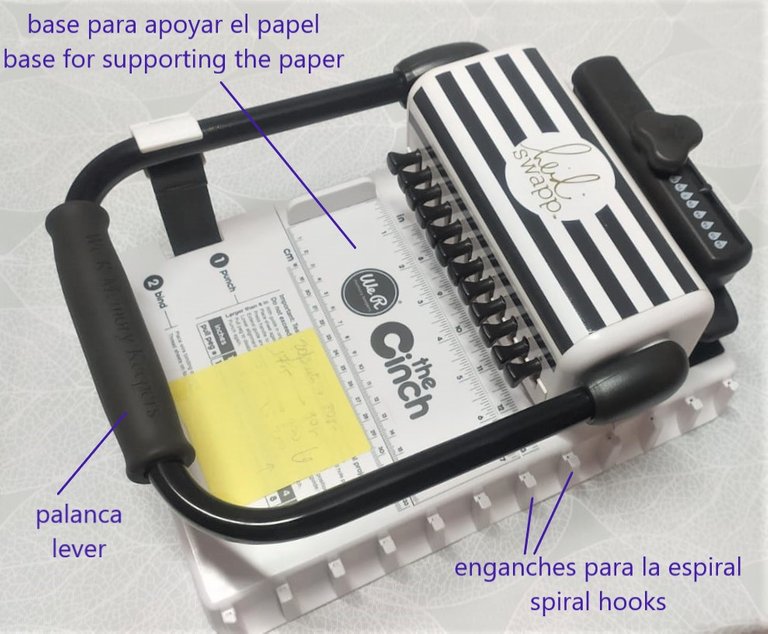¡Hola, Mundo!
Las herramientas de encuadernación en scrapbooking son un "must have". Como ya hemos comentado en multitud de ocasiones, nos bastan con unas tijeras y una plegadora para trabajar, incluso para hacer las más bellas encuadernaciones. De hecho, cuando encuadernas de forma totalmente manual, sin el empleo de máquina alguna, tus trabajos tienen ese aire genuino y auténtico que lo harán insuperables. Eso sí, si cuentas con una encuadernadora o algún otro artilugio que te facilite la encuadernación, te sentirás la reina del scrapbooking.
Hi, World!
Scrapbooking binding tools are a "must have". As we have already mentioned on many occasions, we only need a pair of scissors and a folding machine to work, even to make the most beautiful bindings. In fact, when you bind completely by hand, without the use of any machine, your work has that genuine and authentic air that will make it unbeatable. Of course, if you have a binding machine or some other gadget that makes binding easier, you will feel like the queen of scrapbooking.

Yo dejaría a un lado las encuadernadoras que tienen las papelerías y las reprografías, conocidas como de "espirales" o de "canutillo", que sin entrar en que te guste más o menos su acabado, el principal inconveniente que tienen es que el grosor de las tapas que puedes taladrar es tan fino, que cualquier trabajo de scrapbooking queda fuera de sus posibilidades. Tienen mucha capacidad de trabajo, en el sentido que puedes taladrar doce, veinte o veinticinco páginas de una vez (de 80 gramos por centímetro cuadrado), dependiendo del modelo, a todo el largo de un folio o un A4, pero sólo podrás perforar una tapa de un milímetro de grosor como mucho, que es menos que el chipboard que usamos nosotras antes incluso de forrarlo con cualquier papel. Esto limita bastante nuestras opciones. Esto ocurre con las que hacen agujeros redondos y que insertan espirales metálicas (forradas de plástico) y también con las que hacen perforaciones rectangulares estrechas que son para los canutillos de plástico. Hay que mencionar las encuadernadoras térmicas, que funden y pegan con un adhesivo el lomo de las páginas. Tampoco nos gustan.
I would leave aside the binding machines that stationers and reprographers have, known as "spiral" or "comb" binders, which, without going into whether you like their finish more or less, the main disadvantage they have is that the thickness of the covers that you can drill is so thin that any scrapbooking work is out of their possibilities. They have a lot of work capacity, in the sense that you can punch twelve, twenty or twenty-five pages at a time (80 grams per square centimetre), depending on the model, the full length of a sheet of paper or A4, but you can only punch a cover one millimetre thick at most, which is less than the chipboard we use before even lining it with any paper. This limits our options quite a lot. This is true of those that make round holes and insert metal spirals (lined with plastic) and also of those that make narrow rectangular holes for the plastic grommets. It is worth mentioning the thermal binders, which melt and glue the spine of the pages together with an adhesive. We don't like them either.
Nada tiene ver todo esto con las encuadernadoras que usamos las escraperas. No sólo por la funcionalidad y los acabados que nos permiten, sino porque además ¡son tan bonitas!
All this has nothing to do with the binding machines that we scrapbookers use. Not only because of their functionality and the finishes they allow us, but also because they are so beautiful!

Casi todas son compatibles entre sí, es decir, aunque cambies de una marca a otra o elijas modelo que taladra agujeros o cuadraditos, las espirales que se usan son las mismas, así que hay todo un mundo para elegir respecto a colores y acabados: desde los simples blancos y negros, los clásicos oro, bronce o plata vieja, pasando por los actuales rosa dorado y los coloridos azules, amarillos,...
Almost all of them are compatible with each other, that is to say, even if you change from one brand to another or choose a model that drills holes or squares, the spirals used are the same, so there is a whole world to choose from regarding colours and finishes: from the simple black and white, the classic gold, bronze or old silver, through the current golden pink and the colourful blue, yellow,...

Toda encuadernadora consta como mínimo de tres partes:
Every binding machine consists of at least three parts:
- la palanca que acciona las partes movibles que taladran el papel, por un lado, y cerrarán las anillas una vez terminada la encuadernación, por otra.
- the lever that operates the movable parts that punch the paper on one side and close the rings when the binding is finished on the other side. - la marca que indica el centro de la encuadernación.
- the mark indicating the centre of the binding.


- el depósito donde irán a parar los restos de las perforaciones:
- the tank where the drilling waste will be deposited:

Otras incorporan además, la base donde se apoyan los papeles que van a ser taladrados y que incluyen marcas de medidas que nos facilitan el trabajo.
Y otras también tienen unos enganches donde colocar las espirales y poder meter cómodamente en los papeles taladrados:
Others also have a base on which to place the paper to be drilled and which include measurement marks to make our work easier.
And others also have hooks where to place the spirals and be able to put them comfortably in the drilled papers:


Es importante recordar que antes de comenzar a usar cualquier encuadernadora (y cualquier herramienta sobre todo metálica) debes hacer varios taladros con papeles que no necesites, para limpiarla, pues suelen venir engrasadas de fábrica, y te puede manchar tu trabajo.
It is important to remember that before starting to use any binding machine (and any tool, especially a metal one) you should make several holes with paper that you do not need, to clean it, as they are usually greased from the factory, and this can stain your work.
Por otro lado que para trabajar con encuadernadoras de espirales, tendremos que hacer uso de una herramienta auxiliar: los alicates, para cortar las anillas a la medida que necesitemos y también para cerrarlas en el caso que nos gusten con esa terminación:
On the other hand, to work with spiral binders, we will have to make use of an auxiliary tool: the pliers, to cut the rings to the size we need and also to close them if we like them with that finish:

Hasta aquí las encuadernadoras más comunes. Podemos ver en futuras publicaciones otros modelos de encuadernadoras que realizan perforaciones diferentes y, sobre todo, que no usan las espirales como sujeción del papel. Son opciones muy divertidas y versátiles que dan mucho juego a la hora de estructurar los trabajos de scrapbooking.
También podemos hacer uso de los taladros de palanca para perforar agujeros y realizar sencillas encuadernaciones que cerraríamos con anillas de bisagra. Actualmente las fabrican incluso de colores que están muy a la moda y quedan trabajos preciosos.
These are the most common binding machines. We may see in future publications other models of binding machines that make different perforations and, above all, that do not use spirals to hold the paper. They are very fun and versatile options that give a lot of play when it comes to structuring scrapbooking projects.
We can also make use of lever-action drills to punch holes and make simple bindings that we would close with hinge rings. Nowadays, they are even made in trendy colours, which are very fashionable and make beautiful works.
Por supuesto tampoco hemos mencionado la herramienta más sencilla y antigua para encuadernar: la aguja. Pero para ello tendremos que dejar una publicación exclusiva, pues hay infinidad de técnicas de cosido y posibilidades en este ámbito.
**Of course we haven't mentioned the simplest and oldest tool for bookbinding either: the needle. But for that we will have to leave an exclusive publication, as there are countless sewing techniques and possibilities in this area. **
Gracias por leerme.
Te doy la bienvenida a miAu!
Thank you for reading me.
I welcome you to miAu!
Traducido gracias a la versión gratuita de www.DeepL.com/Translator
Translated with www.DeepL.com/Translator (free version)






Congratulations @marguimiau! You have completed the following achievement on the Hive blockchain and have been rewarded with new badge(s):
Your next target is to reach 100 comments.
You can view your badges on your board and compare yourself to others in the Ranking
If you no longer want to receive notifications, reply to this comment with the word
STOPTo support your work, I also upvoted your post!
Check out the last post from @hivebuzz:
Support the HiveBuzz project. Vote for our proposal!
¡Gracias por vuestro apoyo, @sancho.panza y @cervantes!
¡Gracias por difundir mi trabajo, @marcocasario !
¡Gracias por difundir mi publicación, @cribbio !
¡Gracias por compartir mi publicación, @gasaeightyfive !